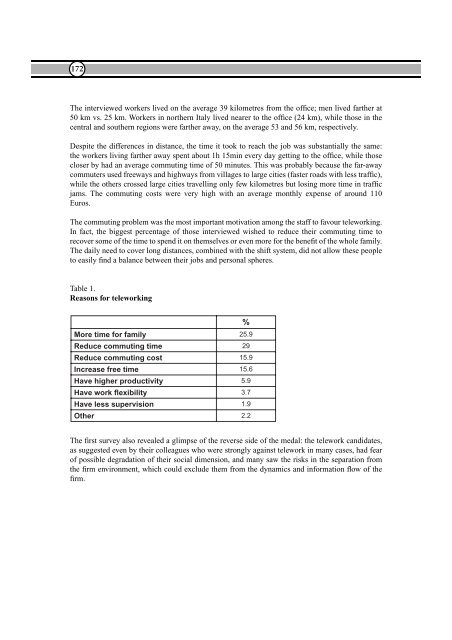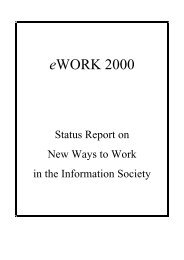Proceedings of 8th European Assembly on telework (Telework2001)
Proceedings of 8th European Assembly on telework (Telework2001)
Proceedings of 8th European Assembly on telework (Telework2001)
You also want an ePaper? Increase the reach of your titles
YUMPU automatically turns print PDFs into web optimized ePapers that Google loves.
172The interviewed workers lived <strong>on</strong> the average 39 kilometres from the <str<strong>on</strong>g>of</str<strong>on</strong>g>fice; men lived farther at50 km vs. 25 km. Workers in northern Italy lived nearer to the <str<strong>on</strong>g>of</str<strong>on</strong>g>fice (24 km), while those in thecentral and southern regi<strong>on</strong>s were farther away, <strong>on</strong> the average 53 and 56 km, respectively.Despite the differences in distance, the time it took to reach the job was substantially the same:the workers living farther away spent about 1h 15min every day getting to the <str<strong>on</strong>g>of</str<strong>on</strong>g>fice, while thosecloser by had an average commuting time <str<strong>on</strong>g>of</str<strong>on</strong>g> 50 minutes. This was probably because the far-awaycommuters used freeways and highways from villages to large cities (faster roads with less traffic),while the others crossed large cities travelling <strong>on</strong>ly few kilometres but losing more time in trafficjams. The commuting costs were very high with an average m<strong>on</strong>thly expense <str<strong>on</strong>g>of</str<strong>on</strong>g> around 110Euros.The commuting problem was the most important motivati<strong>on</strong> am<strong>on</strong>g the staff to favour <strong>telework</strong>ing.In fact, the biggest percentage <str<strong>on</strong>g>of</str<strong>on</strong>g> those interviewed wished to reduce their commuting time torecover some <str<strong>on</strong>g>of</str<strong>on</strong>g> the time to spend it <strong>on</strong> themselves or even more for the benefit <str<strong>on</strong>g>of</str<strong>on</strong>g> the whole family.The daily need to cover l<strong>on</strong>g distances, combined with the shift system, did not allow these peopleto easily find a balance between their jobs and pers<strong>on</strong>al spheres.Table 1.Reas<strong>on</strong>s for <strong>telework</strong>ing%More time for family 25.9Reduce commuting time 29Reduce commuting cost 15.9Increase free time 15.6Have higher productivity 5.9Have work flexibility 3.7Have less supervisi<strong>on</strong> 1.9Other 2.2The first survey also revealed a glimpse <str<strong>on</strong>g>of</str<strong>on</strong>g> the reverse side <str<strong>on</strong>g>of</str<strong>on</strong>g> the medal: the <strong>telework</strong> candidates,as suggested even by their colleagues who were str<strong>on</strong>gly against <strong>telework</strong> in many cases, had fear<str<strong>on</strong>g>of</str<strong>on</strong>g> possible degradati<strong>on</strong> <str<strong>on</strong>g>of</str<strong>on</strong>g> their social dimensi<strong>on</strong>, and many saw the risks in the separati<strong>on</strong> fromthe firm envir<strong>on</strong>ment, which could exclude them from the dynamics and informati<strong>on</strong> flow <str<strong>on</strong>g>of</str<strong>on</strong>g> thefirm.








